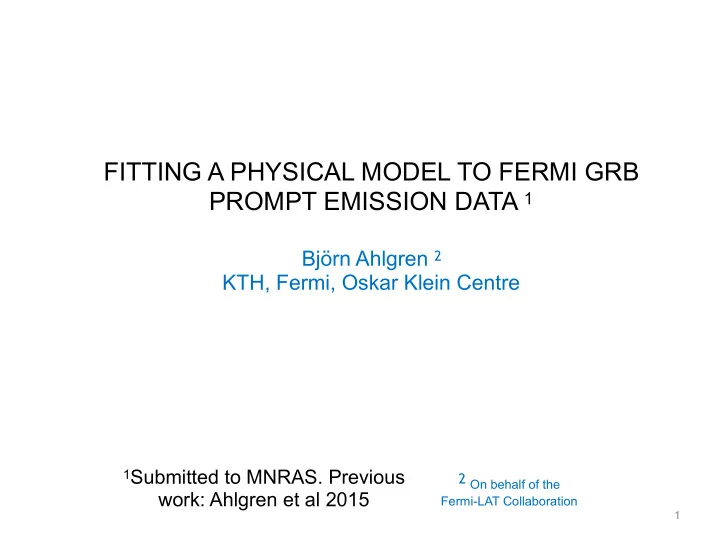

FITTING A PHYSICAL MODEL TO FERMI GRB PROMPT EMISSION DATA 1 Björn Ahlgren 2 KTH, Fermi, Oskar Klein Centre 1 Submitted to MNRAS. Previous 2 On behalf of the work: Ahlgren et al 2015 Fermi-LAT Collaboration 1
Gamma-ray bursts • L iso > 10 50 erg/s • Cosmological distances • Long and short bursts pertain to type Ic supernovae and binary compact object mergers, respectively T 90 distribution of bursts from the BATSE 4B catalogue, (BATSE 2001)
Prompt emission Afterglow emission Typical prompt • Origin of GRB prompt origin region emission origin emission remains region unknown • Laboratory for fundamental physics in extreme conditions • Increase our understanding of dying stars • Using GRBs as cosmological probes Artists impression of a long GRB
The fireball model • Derived using simple assumptions and thermodynamical scaling laws • Few parameter model which is easy to expand upon using more refined emission mechanisms Γ r 0 r ph Schematics of the fireball scenario
GRB data analysis • Physical models are complex and non- log EF E analytical Ep β α • Hard to fit • Empirical models are fitted to data and log E then compared with physical models Empirical function to describe GRB prompt emission
GRB data analysis • Spectral shapes are log EF E Synchrotron highly dependent on fitted model • Hard to reconcile the Observed empirical functions Planck function with physical log E processes
A way forward • We create DREAM, a physical model for subphotospheric dissipation, which can be easily fitted to data • We fit DREAM to a large sample of Fermi GRBs • We can successfully describe a third of the fitted spectra 7
FITTING A PHYSICAL MODEL TO FERMI GRB PROMPT EMISSION DATA • Subphotospheric dissipation and the DREAM • Summary of data sample and data analysis • Results • Review and conclusions 8
DREAM model scenario Dissipation with Radiative Emission as A table Model (DREAM) Photosphere, End of r ph Dissipation dissipation radius, ε , τ Saturation L0,52 radius, Γ Compact object • Scenario based on the fireball model and internal shocks • Assume most dissipated energy goes to thermal electrons • Simulated using code from Pe’er et al (2005) 9
Creating a table model • Table model = lookup table • Optical depth at dissipation τ = 1 - 35 of model spectra • Lorentz factor • Span a 4 dimensional grid Γ = 100 - 500 of model parameters, using 1350 grid points • Isotropic fireball luminosity L 0,52 = 0.1 - 300 erg/s • Physically motivated • Fraction of dissipated energy parameter boundaries ε = 0.01 - 0.4 • Xspec interpolates in table • Main model has negligible model to perform fits synchrotron radiation 10
Data sample and analysis • Fluence > 10 -5 erg/s • Known redshift • Detected before 2016-06-01 36 long Fermi GRBs 11
Data sample and analysis • Time resolved Xspec 4000 analysis 3500 3000 • Bayesian blocks counts s − 1 2500 binning with SNR cut 2000 • Avoid spectral evolution 1500 in fitted spectra 1000 − 10 0 10 20 30 40 Time (s) • Goodness-of-fit test with Light curve and binning for GRB 100414A. Monte Carlo Red regions are excluded for low SNR 12
Results 33 % • 36 bursts 67 % • 293 spectral fits 1000 1000 • 96 accepted E E 100 F F 100 E E fits 10 10 1 10 data / model 10 Ratio Ratio • 197 rejected 1 1 0 . 1 0 . 1 fits 10 4 10 5 10 6 10 100 1000 10 4 10 100 1000 E (keV) E (keV) Example of a Example of an rejected fit accepted fit 13
Rejected fits • Predicted flux too small 1000 • Due to specific 100 EF E choice of 10 dissipation scenario 1 • Possibly sign of data / model 10 Ratio multi-zone emission 1 0 . 1 • Generally not the 10 4 10 5 10 6 10 100 1000 spectral shape which E (keV) is the issue Typical rejected fit 14
Accepted fits Dissipation radius, ε Saturation L0,52 radius, Γ Compact 15 object
Correlations 10 55 r = 0.89 p= 1.57e-21 • Strong correlation between 10 54 model and observed 10 53 L 0,52 luminosity 10 52 10 51 • Clear correlation between 10 50 10 50 10 51 10 52 10 53 10 54 10 55 L 0,52 - Γ , also found by Lü et L iso,z al (2012) • Correlation within some 10 2 bursts between Γ and E peak L 0,52 10 1 • No other correlations to 10 0 r = 0.75 Band function parameters p= 5.42e-14 100 200 300 400 500 Γ Γ 16
Summary and conclusions • This is the first time a physical model is fitted to a large sample of GRBs • The DREAM model shows that, for the prompt emission of at least some GRBs, photospheric emission is a promising candidate • Main challenge is inability to reproduce the most luminous spectra which constrains underlying model assumptions 17
Recommend
More recommend